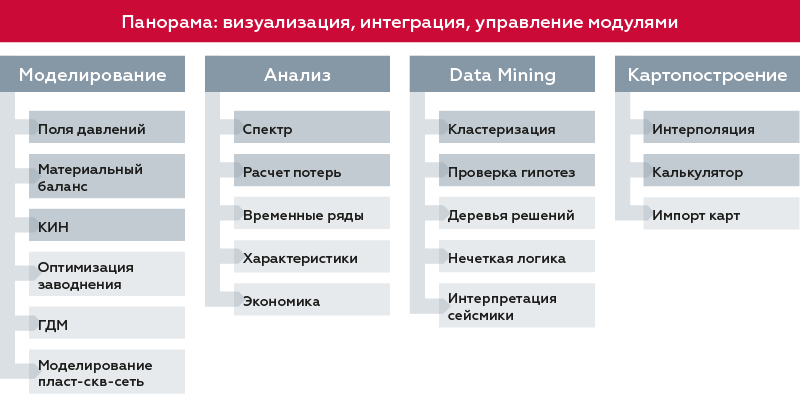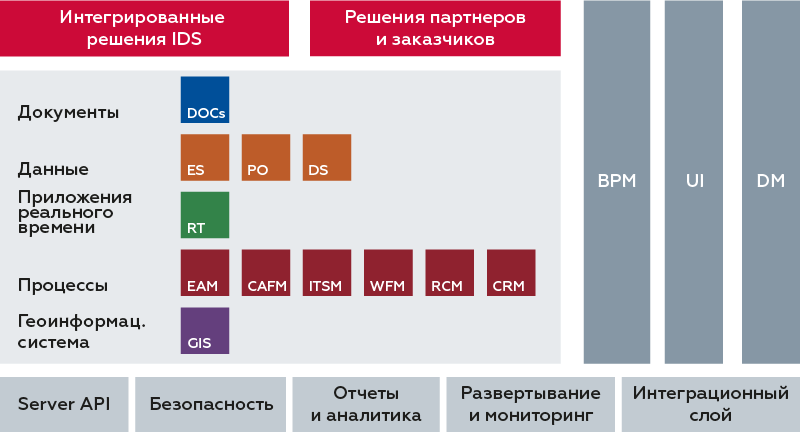Import Substitution in the Oil and Gas Sector: How Mining Companies at Elbrus Gathered
Finding a replacement for imported solutions from Russian analogues is important for two reasons. First, in modern conditions, no one can guarantee the availability of technology, and secondly, the question of information security at the national level arises. As a “potential adversary,” many Western companies do not want to supply the latest technology and technology to Russia, and leading Russian oil and gas companies fear the presence of “tabs” in the systems supplied - that is, industrial espionage, distortion of work results and the possibility of hacking networks.

In the wake of talks about import substitution, a huge amount of domestic products appeared on the market to control the processes of exploration of the subsoil, assessing oil and gas reserves, and developing and operating fields, most of which have been successfully registered in the Russian software registry. However, large customers continue to order imported hardware-software systems, which not only cost much more, but also make the entire industry dependent on certain suppliers. The degree of import dependence in the oil and gas industry is still high. It all the same happens because the individual development programs of Russian companies, even being successful, have two drawbacks.
Lack of number 1. Lack of infrastructure
')
No one in a major oil and gas company needs a separate module for analyzing, for example, the efficiency of well construction. This function, of course, is necessary, but only together with all other elements of the management of the infrastructure of deposits - from minor technical details to planning and budgeting. By purchasing a ready-made complex from Schlumberger, the customer can be sure that all elements of the system will work with each other. But who will be responsible for the special module acquired from an innovative Russian company? Who will be responsible for its development if the company goes bankrupt with the next wave of problems in the domestic economy? Management does not want to take responsibility for these risks and selects proven and reliable platforms.
The lack of number 2. Use of imported ecosystem
The absolute majority of Russian software is based on the elemental base of foreign production - processors and chips, as a rule, x86 platforms. But this would be half the trouble when it comes to software under Microsoft OS or using closed development tools also imported. Tell me, if the software was compiled on the American platform using American software libraries, can it be considered 100% Russian and protected from possible loopholes?
Here we are not talking about some kind of patriotic substitution of foreign products, but about simple industrial risks - after all, if new sanctions are imposed, certain computer systems may simply be banned for delivery to Russia, and oil and gas companies are afraid of potential IT-sabotage or industrial espionage. .
Our story began when a representative of one of the hydrocarbon producers asked the RedSys company, asking them to create systems less dependent on imported components that could take on modeling of work on wells. As a business IT integrator, RedSys, possessing great expertise in the field of selection, development and implementation of innovative technologies, began to look for ready-made products that could be suitable for solving this problem. As a result, a software and hardware complex was created that provides support for over 90% of the development management processes at the fields.
It is based on:
• The Elbrus platform , an ecosystem created by CJSC “MCST”, which includes motherboards, microprocessors, an operating system and a development environment originally created in Russia. At one time, the team of "Elbrus" was the foremost production in the USSR (a term to match the era), later developed for foreign companies, and in the 2000s began to produce their own processors that have sufficient performance, but most importantly - can work with extensive memory fields That is the best for engineering modeling.
• CONCORD system , developed since 1998 environment for the analysis and modeling of oil and gas production processes. The solution includes 4 basic modules that combine the tasks of analysis, modeling, forecasting and visualization of physical processes in wells. CONCORD products are interesting because they support a whole ecosystem of modules for solving interrelated tasks in the oil and gas sector.

• IDS X360 system , developed in Russia a platform for building corporate information systems with ready reference books, business processes, forms and document templates. X360 includes ready-made modules EAM, REM, ITSM, WFM, RCM, CRM, BPM, as well as GIS geographic information system, making it suitable for managing the field as a business object.

It would seem that the elements of the “designer” were quite suitable for creating a ready-made complex, but in order for the theory to become a practice, a lot of preparatory work had to be carried out, including with the involvement of developers of the hardware platform.
By itself, the Elbrus platform includes its own operating system (and with different kernel versions for different tasks). OS "Elbrus" is based on the Linux Debian distribution, but it is significantly different from the original kernel code. In particular, the kernel already has built-in tools for information protection, which allow to achieve 2 levels of security on the State Technical Commission RD, and can also work as a real-time OS designed for solving industrial problems. For x86 architecture, the MCST specialists created binary translation tools - a kind of emulator that allows you to run standard applications.
But back to our situation: on the Elbrus platform, it was necessary to launch the CONCORD solutions and the IDS X360 system. Both designs use open standards, but for their work it was necessary to make certain changes to the architecture of the software and hardware complex.
CONCORD applications were originally developed for launch in Docker containers. But since “Elbrus” does not work with Docker, and launching ready-made images with third-party operating systems (for example, with Ubuntu) cuts the very idea of import substitution at the root, it was necessary to find another solution for working with CONCORD. Having studied the capabilities of the Elbrus OS, the developers decided to use LXC containers.
With the IDS X360 came out a little harder. The system consists of three components - a PostgreSQL database, an application server and a search system. The database started without any problems, however, the application server needs support for NodeJS (and in particular the JIT compiler). And here the origin of the developer of the platform played an important role. It is impossible to imagine that IBM or HP changed its development plans for a Russian customer. Meanwhile, the Elbrus team took about a month to respond to IDS requests and provide support for NodeJS in the internal release of the operating system. The official release with the support of NodeJS is scheduled for autumn 2017. By the way, at the same time it is planned to introduce Java support, which will become the basis for the work of Elastic Search - the third component of IDS X360.
The teams of engineers from IDS and CONCORD were provided with test access to the Elbrus server. These are 4 Elbrus-4 processors with 4 cores each in the 3U form factor. The cores run at 800 MHz, the system has 96 GB of RAM (up to 192 GB possible), two KPI south bridges. Both teams reported on the success of the systems on the Elbrus complex, mainly due to accelerated memory access and the presence of a large amount of RAM.
In the near future, we are also waiting for load testing, which will show real performance in comparison with complexes based on x86 architecture, but the fact that the software suite for the oil and gas sector is already running on Elbrus without a binary translation and benefits from running on a domestic hardware platform and domestic operating system. They use the embedded Elbrus kernel virtualization system, which means that the whole software complex can be run on the same virtualization host.
Why is this turnkey solution viable? Because it includes the entire set of components necessary to control the field and simulate the processes in the wells. There is no need to add or integrate any dubious solutions. On the contrary, the customer receives the finished product, a guarantee of protection against sanctions and attention ... the whole complex costs 3-10 times cheaper than foreign integrated counterparts, which contain all the same components.
The next step is the transition to the use of Russian programming platforms, compilers and development tools designed specifically for the Elbrus and MCST-R systems, which can be found on the MCST website (http://www.mcst.ru/sistema_programmirovaniya). This approach will provide complete “import independence” for the critical elements of the IT landscape of oil and gas companies.

In the wake of talks about import substitution, a huge amount of domestic products appeared on the market to control the processes of exploration of the subsoil, assessing oil and gas reserves, and developing and operating fields, most of which have been successfully registered in the Russian software registry. However, large customers continue to order imported hardware-software systems, which not only cost much more, but also make the entire industry dependent on certain suppliers. The degree of import dependence in the oil and gas industry is still high. It all the same happens because the individual development programs of Russian companies, even being successful, have two drawbacks.
Lack of number 1. Lack of infrastructure
')
No one in a major oil and gas company needs a separate module for analyzing, for example, the efficiency of well construction. This function, of course, is necessary, but only together with all other elements of the management of the infrastructure of deposits - from minor technical details to planning and budgeting. By purchasing a ready-made complex from Schlumberger, the customer can be sure that all elements of the system will work with each other. But who will be responsible for the special module acquired from an innovative Russian company? Who will be responsible for its development if the company goes bankrupt with the next wave of problems in the domestic economy? Management does not want to take responsibility for these risks and selects proven and reliable platforms.
The lack of number 2. Use of imported ecosystem
The absolute majority of Russian software is based on the elemental base of foreign production - processors and chips, as a rule, x86 platforms. But this would be half the trouble when it comes to software under Microsoft OS or using closed development tools also imported. Tell me, if the software was compiled on the American platform using American software libraries, can it be considered 100% Russian and protected from possible loopholes?
Here we are not talking about some kind of patriotic substitution of foreign products, but about simple industrial risks - after all, if new sanctions are imposed, certain computer systems may simply be banned for delivery to Russia, and oil and gas companies are afraid of potential IT-sabotage or industrial espionage. .
Is there no element base in Russia?
Our story began when a representative of one of the hydrocarbon producers asked the RedSys company, asking them to create systems less dependent on imported components that could take on modeling of work on wells. As a business IT integrator, RedSys, possessing great expertise in the field of selection, development and implementation of innovative technologies, began to look for ready-made products that could be suitable for solving this problem. As a result, a software and hardware complex was created that provides support for over 90% of the development management processes at the fields.
It is based on:
• The Elbrus platform , an ecosystem created by CJSC “MCST”, which includes motherboards, microprocessors, an operating system and a development environment originally created in Russia. At one time, the team of "Elbrus" was the foremost production in the USSR (a term to match the era), later developed for foreign companies, and in the 2000s began to produce their own processors that have sufficient performance, but most importantly - can work with extensive memory fields That is the best for engineering modeling.
• CONCORD system , developed since 1998 environment for the analysis and modeling of oil and gas production processes. The solution includes 4 basic modules that combine the tasks of analysis, modeling, forecasting and visualization of physical processes in wells. CONCORD products are interesting because they support a whole ecosystem of modules for solving interrelated tasks in the oil and gas sector.

• IDS X360 system , developed in Russia a platform for building corporate information systems with ready reference books, business processes, forms and document templates. X360 includes ready-made modules EAM, REM, ITSM, WFM, RCM, CRM, BPM, as well as GIS geographic information system, making it suitable for managing the field as a business object.

It would seem that the elements of the “designer” were quite suitable for creating a ready-made complex, but in order for the theory to become a practice, a lot of preparatory work had to be carried out, including with the involvement of developers of the hardware platform.
Solution Architecture
By itself, the Elbrus platform includes its own operating system (and with different kernel versions for different tasks). OS "Elbrus" is based on the Linux Debian distribution, but it is significantly different from the original kernel code. In particular, the kernel already has built-in tools for information protection, which allow to achieve 2 levels of security on the State Technical Commission RD, and can also work as a real-time OS designed for solving industrial problems. For x86 architecture, the MCST specialists created binary translation tools - a kind of emulator that allows you to run standard applications.
But back to our situation: on the Elbrus platform, it was necessary to launch the CONCORD solutions and the IDS X360 system. Both designs use open standards, but for their work it was necessary to make certain changes to the architecture of the software and hardware complex.
CONCORD applications were originally developed for launch in Docker containers. But since “Elbrus” does not work with Docker, and launching ready-made images with third-party operating systems (for example, with Ubuntu) cuts the very idea of import substitution at the root, it was necessary to find another solution for working with CONCORD. Having studied the capabilities of the Elbrus OS, the developers decided to use LXC containers.
With the IDS X360 came out a little harder. The system consists of three components - a PostgreSQL database, an application server and a search system. The database started without any problems, however, the application server needs support for NodeJS (and in particular the JIT compiler). And here the origin of the developer of the platform played an important role. It is impossible to imagine that IBM or HP changed its development plans for a Russian customer. Meanwhile, the Elbrus team took about a month to respond to IDS requests and provide support for NodeJS in the internal release of the operating system. The official release with the support of NodeJS is scheduled for autumn 2017. By the way, at the same time it is planned to introduce Java support, which will become the basis for the work of Elastic Search - the third component of IDS X360.
Preliminary testing and expectations
The teams of engineers from IDS and CONCORD were provided with test access to the Elbrus server. These are 4 Elbrus-4 processors with 4 cores each in the 3U form factor. The cores run at 800 MHz, the system has 96 GB of RAM (up to 192 GB possible), two KPI south bridges. Both teams reported on the success of the systems on the Elbrus complex, mainly due to accelerated memory access and the presence of a large amount of RAM.
In the near future, we are also waiting for load testing, which will show real performance in comparison with complexes based on x86 architecture, but the fact that the software suite for the oil and gas sector is already running on Elbrus without a binary translation and benefits from running on a domestic hardware platform and domestic operating system. They use the embedded Elbrus kernel virtualization system, which means that the whole software complex can be run on the same virtualization host.
Why is this turnkey solution viable? Because it includes the entire set of components necessary to control the field and simulate the processes in the wells. There is no need to add or integrate any dubious solutions. On the contrary, the customer receives the finished product, a guarantee of protection against sanctions and attention ... the whole complex costs 3-10 times cheaper than foreign integrated counterparts, which contain all the same components.
The next step is the transition to the use of Russian programming platforms, compilers and development tools designed specifically for the Elbrus and MCST-R systems, which can be found on the MCST website (http://www.mcst.ru/sistema_programmirovaniya). This approach will provide complete “import independence” for the critical elements of the IT landscape of oil and gas companies.
Source: https://habr.com/ru/post/337730/
All Articles